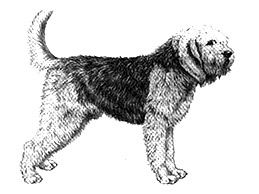Otterhound Breed Standard
Last updated: 05 Aug 2009
A breed standard is the guideline which describes the ideal characteristics, temperament, and appearance of a breed and ensures that the breed is fit for function with soundness essential. Breeders and judges should at all times be mindful of features which could be detrimental in any way to the health, welfare or soundness of this breed.

Kennel Club, London 1994
FCI Standard No 294
-
Group:
Group 4 (Hounds)
-
History:
-
General Appearance:
Large, straight limbed and sound, rough coated with majestic head, strong body and loose, long striding action. Rough double coat and large feet essential. Free moving.
-
Characteristics:
Big, strong hound primarily built for long day's work in water but able to gallop on land.
-
Temperament:
Amiable and even-tempered. Signs of aggression or nervousness should be heavily penalised.
-
Head And Skull:
Clean, very imposing, deep rather than wide, clean cheekbones, skull nicely domed neither coarse nor overdone, rising from distinct though not exaggerated stop to slight peak at occiput. No trace of scowl or bulge on forehead, expression being open and amiable. Muzzle strong, deep; with good wide nose, wide nostrils. Distance from nose-end to stop slightly shorter than from stop to occiput. Plenty of lip and flew, but not exaggerated. Whole head except for nose well covered with rough hair, ending in slight moustaches and beard.
-
Eyes:
Intelligent, moderately deep set eye; haw showing only slightly. Eye colour and rim pigment variable according to coat colour (a blue and tan hound may have hazel eyes). Yellow eye undesirable.
-
Ears:
Unique feature of the breed. Long, pendulous, set on level with corner or eye; easily reaching nose when pulled forward, with characteristic fold. Leading edge folding or rolling inwards giving curious draped appearance - an essential point not to be lost. Well covered and fringed with hair.
-
Mouth:
Jaws strong, large, well placed teeth with perfect, regular scissor bite, i.e. the upper teeth closely overlapping the lower teeth and set square to the jaws.
-
Neck:
Long, powerful, set smoothly into well laid back, clean shoulders. Slight dewlap permissible.
-
Forequarters:
Well laid shoulders. Forelegs strongly boned, straight from elbow to ground. Pasterns strong and slightly sprung.
-
Body:
Chest deep with well sprung, fairly deep, oval ribcage. Ribs carried well back allowing plenty of heart and lung room; neither too wide nor too narrow. Body very strong, with level top line and broad back. Loin short and strong.
-
Hindquarters:
Very strong; well muscled when viewed from any angle, standing neither too wide nor too narrow behind. Hind angulation moderate; hocks well let down, turning neither in nor out. Thighs and second thighs heavily muscled. In natural stance, hindlegs from hock to ground perpendicular.
-
Feet:
Large, round, well knuckled, thick padded, turning neither in nor out. Compact but capable of spreading; hind feet only slightly smaller than fore feet. Web must be in evidence.
-
Tail:
(Stern) Set high, carried up when alert or moving, never curling over back and may droop when standing. Thick at base, tapering to point; bone reaching to hock and carried straight or in a slight curve. Hair under tail rather longer and more profuse than that on upper surface.
-
Gait/Movement:
Very loose and shambling at walk, springing immediately into a loose, very long-striding, sound, active trot. Gallop smooth and exceptionally long striding.
-
Coat:
Long 4-8 cm, (1.5-3 ins), dense rough, harsh and waterproof but not wiry of broken appearance. Softer hair on head and lower legs natural. Undercoat evident and there may be a slight oily texture in top and undercoat. Not trimmed for exhibition. Presentation should be natural.
-
Colour:
All recognised hound colours permissible: Whole coloured, grizzle, sandy, red, wheaten, blue; these may have slight white markings on head, chest, feet and tail tip. White hounds may have slight lemon, blue or badger pied markings. Black and tan, blue and tan, black and cream, occasional liver, tan and liver, tan and white. Colours not permissible: Liver and white, a white-bodied hound with black and tan patches distinctly separate. Pigment should harmonise though not necessarily blend with coat colour; for example a tan hound may have a brown nose and eye rims. A slight butterfly nose permissible.
-
Sizes:
Height:
Dogs approx. 69 cms (27 ins) at shoulder
Bitches approx. 61 cms (24 ins) at shoulder
-
Faults:
Any departure from the foregoing points should be considered a fault and the seriousness with which the fault should be regarded should be in exact proportion to its degree and its effect upon the health and welfare of the dog.
-
Notes:
Male animals should have two apparently normal testicles fully descended into the scrotum.
 For owners
For owners
 Members
Members
 Dogs Australia is a not-for-profit organisation advocating for the preservation of purebred dogs through ethical breeding.
It champions the highest standard of animal welfare through education and fostering dog-loving communities.
Internationally recognised and established in 1958 as the Australian National Kennel Council (ANKC),
the organisation promotes responsible dog ownership; maintains the ORCHID* heritable canine diseases database;
funds research into canine diseases; and supports state and territory-based member bodies.
Dogs Australia promotes breed conformation shows and community sports for dogs that fulfil a breed’s natural instincts.
Dogs Australia is a not-for-profit organisation advocating for the preservation of purebred dogs through ethical breeding.
It champions the highest standard of animal welfare through education and fostering dog-loving communities.
Internationally recognised and established in 1958 as the Australian National Kennel Council (ANKC),
the organisation promotes responsible dog ownership; maintains the ORCHID* heritable canine diseases database;
funds research into canine diseases; and supports state and territory-based member bodies.
Dogs Australia promotes breed conformation shows and community sports for dogs that fulfil a breed’s natural instincts.







